Report on Quality Management Tools Implementation at McDonald's
VerifiedAdded on 2023/06/07
|6
|1380
|317
Report
AI Summary
This report examines the application of quality management tools within McDonald's, focusing on the cause and effect diagram (Ishikawa diagram) and check sheets. The introduction highlights the importance of quality in the modern business environment and explains why these specific tools were chosen to analyze McDonald's operations. The report details how these tools help identify quality issues, such as those related to resource availability and healthy food offerings, and how they are implemented within the context of Total Quality Management (TQM) and Six Sigma approaches. The 'Why' section explores the benefits of these tools in understanding and addressing quality challenges, while the 'What' section defines each tool and its function in analyzing variables that affect quality. The report also explains the implementation process, including the use of TQM and structured tables for data collection and analysis. The conclusion emphasizes the significance of quality management in business and the benefits of using these tools to improve product and service quality at McDonald's.
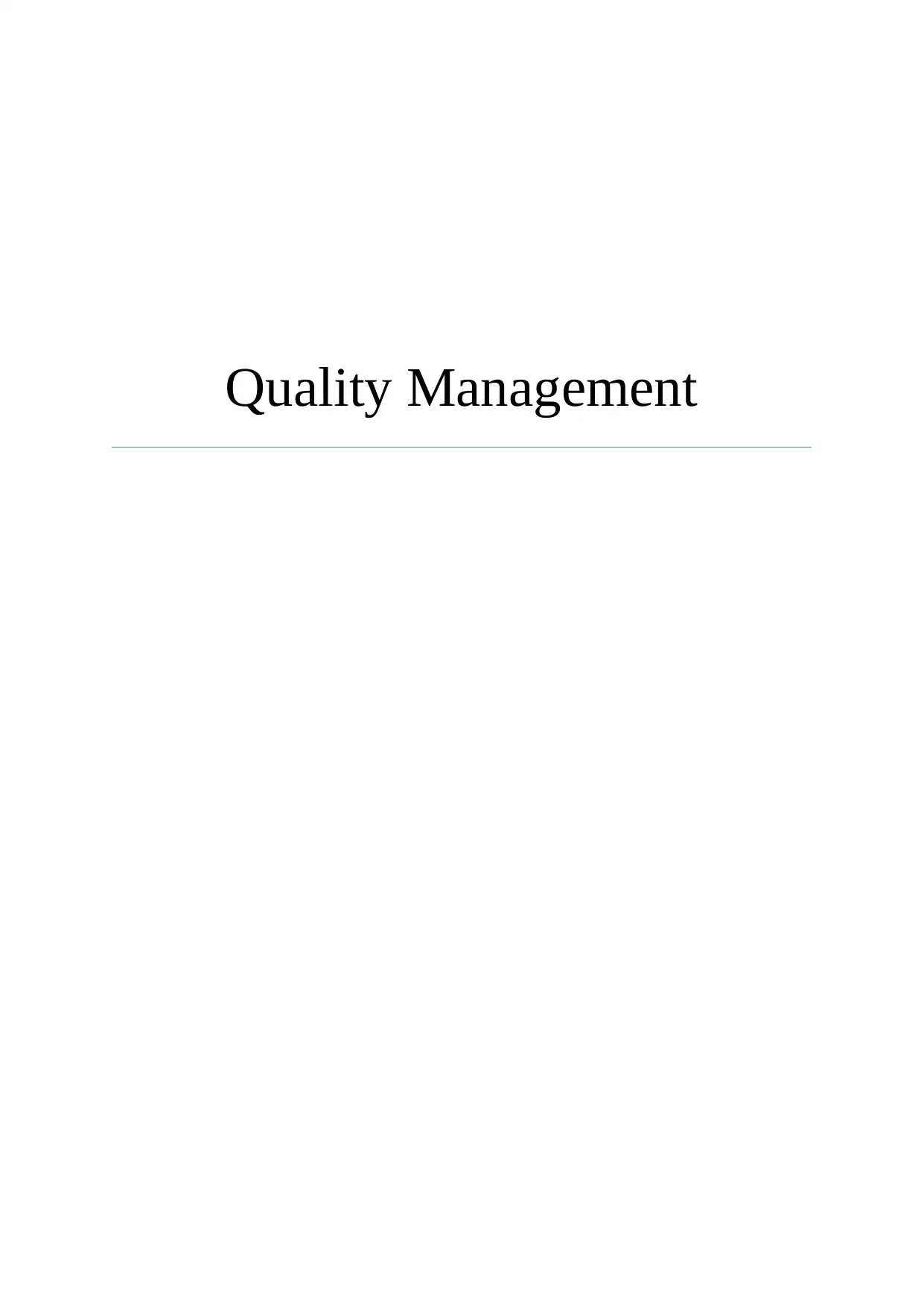
Quality Management
Paraphrase This Document
Need a fresh take? Get an instant paraphrase of this document with our AI Paraphraser
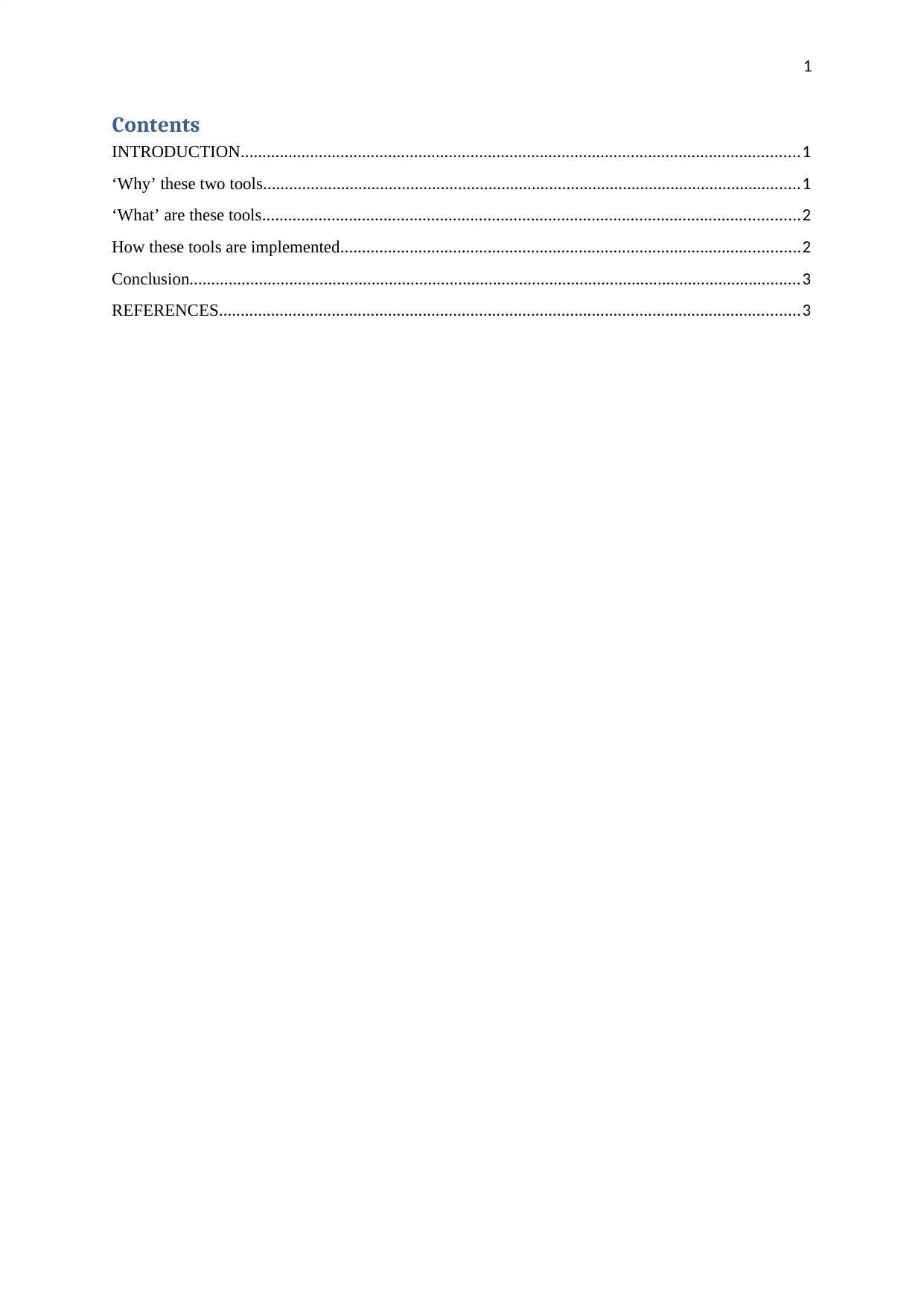
1
Contents
INTRODUCTION.................................................................................................................................1
‘Why’ these two tools............................................................................................................................1
‘What’ are these tools............................................................................................................................2
How these tools are implemented..........................................................................................................2
Conclusion.............................................................................................................................................3
REFERENCES......................................................................................................................................3
Contents
INTRODUCTION.................................................................................................................................1
‘Why’ these two tools............................................................................................................................1
‘What’ are these tools............................................................................................................................2
How these tools are implemented..........................................................................................................2
Conclusion.............................................................................................................................................3
REFERENCES......................................................................................................................................3
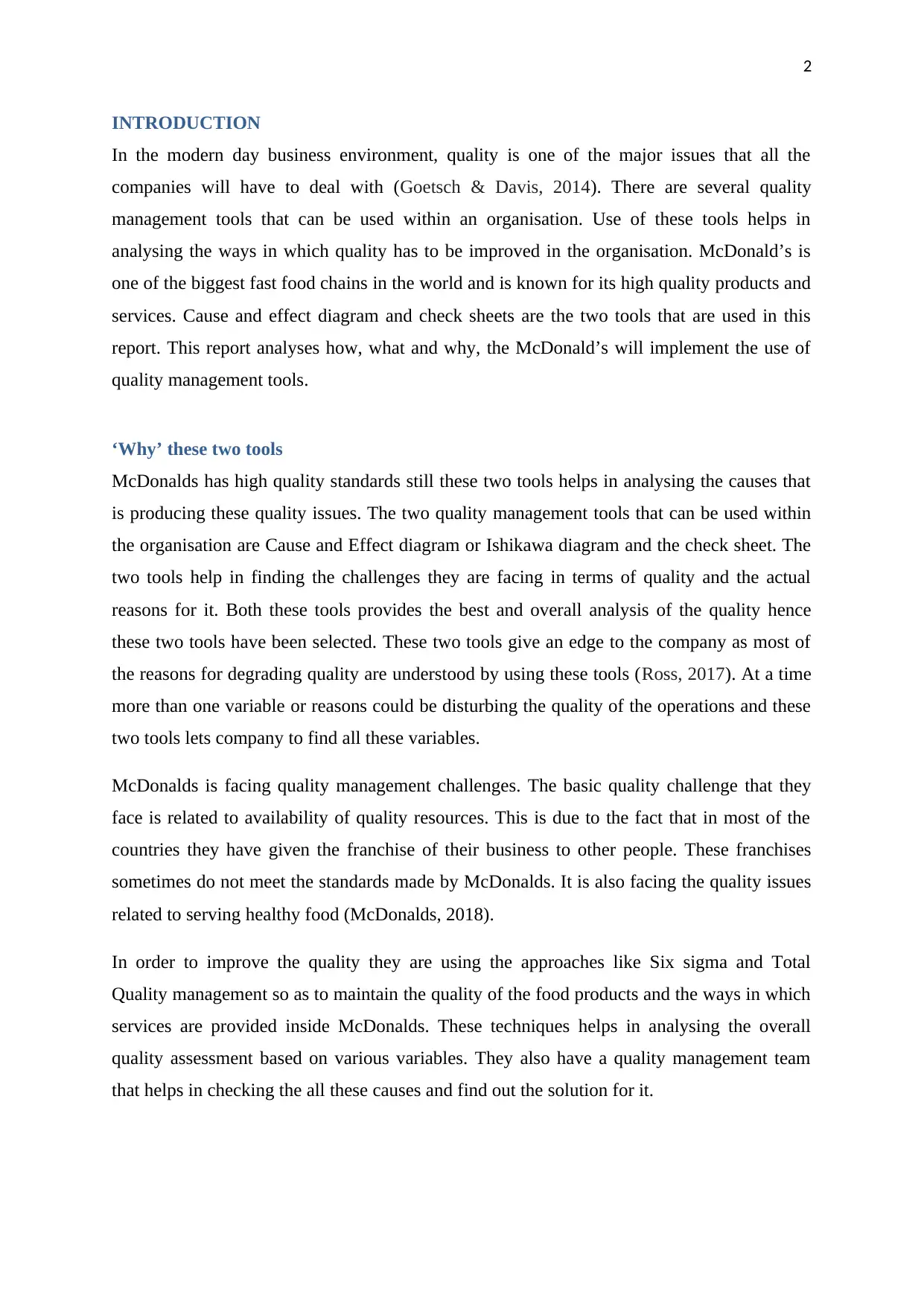
2
INTRODUCTION
In the modern day business environment, quality is one of the major issues that all the
companies will have to deal with (Goetsch & Davis, 2014). There are several quality
management tools that can be used within an organisation. Use of these tools helps in
analysing the ways in which quality has to be improved in the organisation. McDonald’s is
one of the biggest fast food chains in the world and is known for its high quality products and
services. Cause and effect diagram and check sheets are the two tools that are used in this
report. This report analyses how, what and why, the McDonald’s will implement the use of
quality management tools.
‘Why’ these two tools
McDonalds has high quality standards still these two tools helps in analysing the causes that
is producing these quality issues. The two quality management tools that can be used within
the organisation are Cause and Effect diagram or Ishikawa diagram and the check sheet. The
two tools help in finding the challenges they are facing in terms of quality and the actual
reasons for it. Both these tools provides the best and overall analysis of the quality hence
these two tools have been selected. These two tools give an edge to the company as most of
the reasons for degrading quality are understood by using these tools (Ross, 2017). At a time
more than one variable or reasons could be disturbing the quality of the operations and these
two tools lets company to find all these variables.
McDonalds is facing quality management challenges. The basic quality challenge that they
face is related to availability of quality resources. This is due to the fact that in most of the
countries they have given the franchise of their business to other people. These franchises
sometimes do not meet the standards made by McDonalds. It is also facing the quality issues
related to serving healthy food (McDonalds, 2018).
In order to improve the quality they are using the approaches like Six sigma and Total
Quality management so as to maintain the quality of the food products and the ways in which
services are provided inside McDonalds. These techniques helps in analysing the overall
quality assessment based on various variables. They also have a quality management team
that helps in checking the all these causes and find out the solution for it.
INTRODUCTION
In the modern day business environment, quality is one of the major issues that all the
companies will have to deal with (Goetsch & Davis, 2014). There are several quality
management tools that can be used within an organisation. Use of these tools helps in
analysing the ways in which quality has to be improved in the organisation. McDonald’s is
one of the biggest fast food chains in the world and is known for its high quality products and
services. Cause and effect diagram and check sheets are the two tools that are used in this
report. This report analyses how, what and why, the McDonald’s will implement the use of
quality management tools.
‘Why’ these two tools
McDonalds has high quality standards still these two tools helps in analysing the causes that
is producing these quality issues. The two quality management tools that can be used within
the organisation are Cause and Effect diagram or Ishikawa diagram and the check sheet. The
two tools help in finding the challenges they are facing in terms of quality and the actual
reasons for it. Both these tools provides the best and overall analysis of the quality hence
these two tools have been selected. These two tools give an edge to the company as most of
the reasons for degrading quality are understood by using these tools (Ross, 2017). At a time
more than one variable or reasons could be disturbing the quality of the operations and these
two tools lets company to find all these variables.
McDonalds is facing quality management challenges. The basic quality challenge that they
face is related to availability of quality resources. This is due to the fact that in most of the
countries they have given the franchise of their business to other people. These franchises
sometimes do not meet the standards made by McDonalds. It is also facing the quality issues
related to serving healthy food (McDonalds, 2018).
In order to improve the quality they are using the approaches like Six sigma and Total
Quality management so as to maintain the quality of the food products and the ways in which
services are provided inside McDonalds. These techniques helps in analysing the overall
quality assessment based on various variables. They also have a quality management team
that helps in checking the all these causes and find out the solution for it.
⊘ This is a preview!⊘
Do you want full access?
Subscribe today to unlock all pages.

Trusted by 1+ million students worldwide
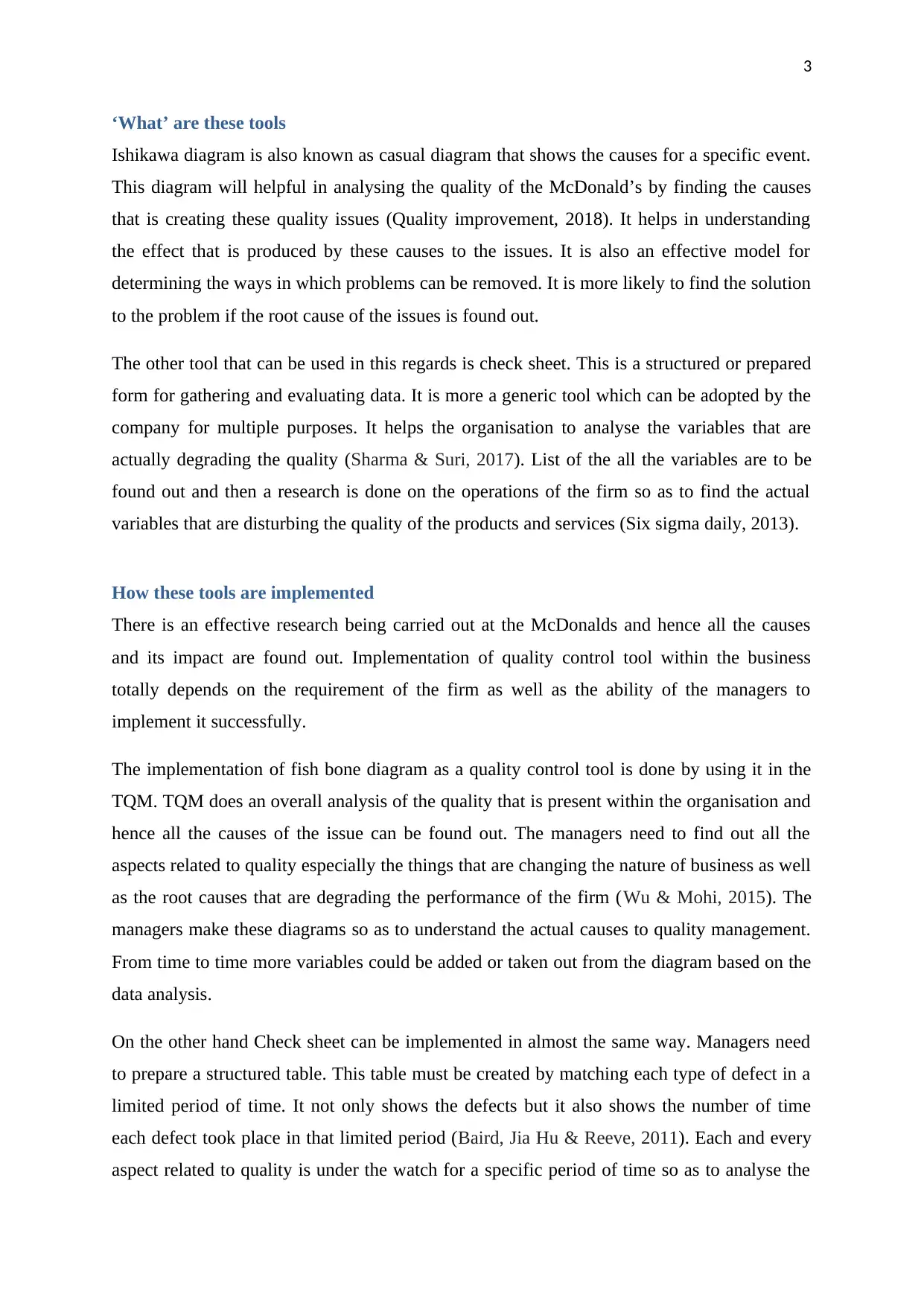
3
‘What’ are these tools
Ishikawa diagram is also known as casual diagram that shows the causes for a specific event.
This diagram will helpful in analysing the quality of the McDonald’s by finding the causes
that is creating these quality issues (Quality improvement, 2018). It helps in understanding
the effect that is produced by these causes to the issues. It is also an effective model for
determining the ways in which problems can be removed. It is more likely to find the solution
to the problem if the root cause of the issues is found out.
The other tool that can be used in this regards is check sheet. This is a structured or prepared
form for gathering and evaluating data. It is more a generic tool which can be adopted by the
company for multiple purposes. It helps the organisation to analyse the variables that are
actually degrading the quality (Sharma & Suri, 2017). List of the all the variables are to be
found out and then a research is done on the operations of the firm so as to find the actual
variables that are disturbing the quality of the products and services (Six sigma daily, 2013).
How these tools are implemented
There is an effective research being carried out at the McDonalds and hence all the causes
and its impact are found out. Implementation of quality control tool within the business
totally depends on the requirement of the firm as well as the ability of the managers to
implement it successfully.
The implementation of fish bone diagram as a quality control tool is done by using it in the
TQM. TQM does an overall analysis of the quality that is present within the organisation and
hence all the causes of the issue can be found out. The managers need to find out all the
aspects related to quality especially the things that are changing the nature of business as well
as the root causes that are degrading the performance of the firm (Wu & Mohi, 2015). The
managers make these diagrams so as to understand the actual causes to quality management.
From time to time more variables could be added or taken out from the diagram based on the
data analysis.
On the other hand Check sheet can be implemented in almost the same way. Managers need
to prepare a structured table. This table must be created by matching each type of defect in a
limited period of time. It not only shows the defects but it also shows the number of time
each defect took place in that limited period (Baird, Jia Hu & Reeve, 2011). Each and every
aspect related to quality is under the watch for a specific period of time so as to analyse the
‘What’ are these tools
Ishikawa diagram is also known as casual diagram that shows the causes for a specific event.
This diagram will helpful in analysing the quality of the McDonald’s by finding the causes
that is creating these quality issues (Quality improvement, 2018). It helps in understanding
the effect that is produced by these causes to the issues. It is also an effective model for
determining the ways in which problems can be removed. It is more likely to find the solution
to the problem if the root cause of the issues is found out.
The other tool that can be used in this regards is check sheet. This is a structured or prepared
form for gathering and evaluating data. It is more a generic tool which can be adopted by the
company for multiple purposes. It helps the organisation to analyse the variables that are
actually degrading the quality (Sharma & Suri, 2017). List of the all the variables are to be
found out and then a research is done on the operations of the firm so as to find the actual
variables that are disturbing the quality of the products and services (Six sigma daily, 2013).
How these tools are implemented
There is an effective research being carried out at the McDonalds and hence all the causes
and its impact are found out. Implementation of quality control tool within the business
totally depends on the requirement of the firm as well as the ability of the managers to
implement it successfully.
The implementation of fish bone diagram as a quality control tool is done by using it in the
TQM. TQM does an overall analysis of the quality that is present within the organisation and
hence all the causes of the issue can be found out. The managers need to find out all the
aspects related to quality especially the things that are changing the nature of business as well
as the root causes that are degrading the performance of the firm (Wu & Mohi, 2015). The
managers make these diagrams so as to understand the actual causes to quality management.
From time to time more variables could be added or taken out from the diagram based on the
data analysis.
On the other hand Check sheet can be implemented in almost the same way. Managers need
to prepare a structured table. This table must be created by matching each type of defect in a
limited period of time. It not only shows the defects but it also shows the number of time
each defect took place in that limited period (Baird, Jia Hu & Reeve, 2011). Each and every
aspect related to quality is under the watch for a specific period of time so as to analyse the
Paraphrase This Document
Need a fresh take? Get an instant paraphrase of this document with our AI Paraphraser
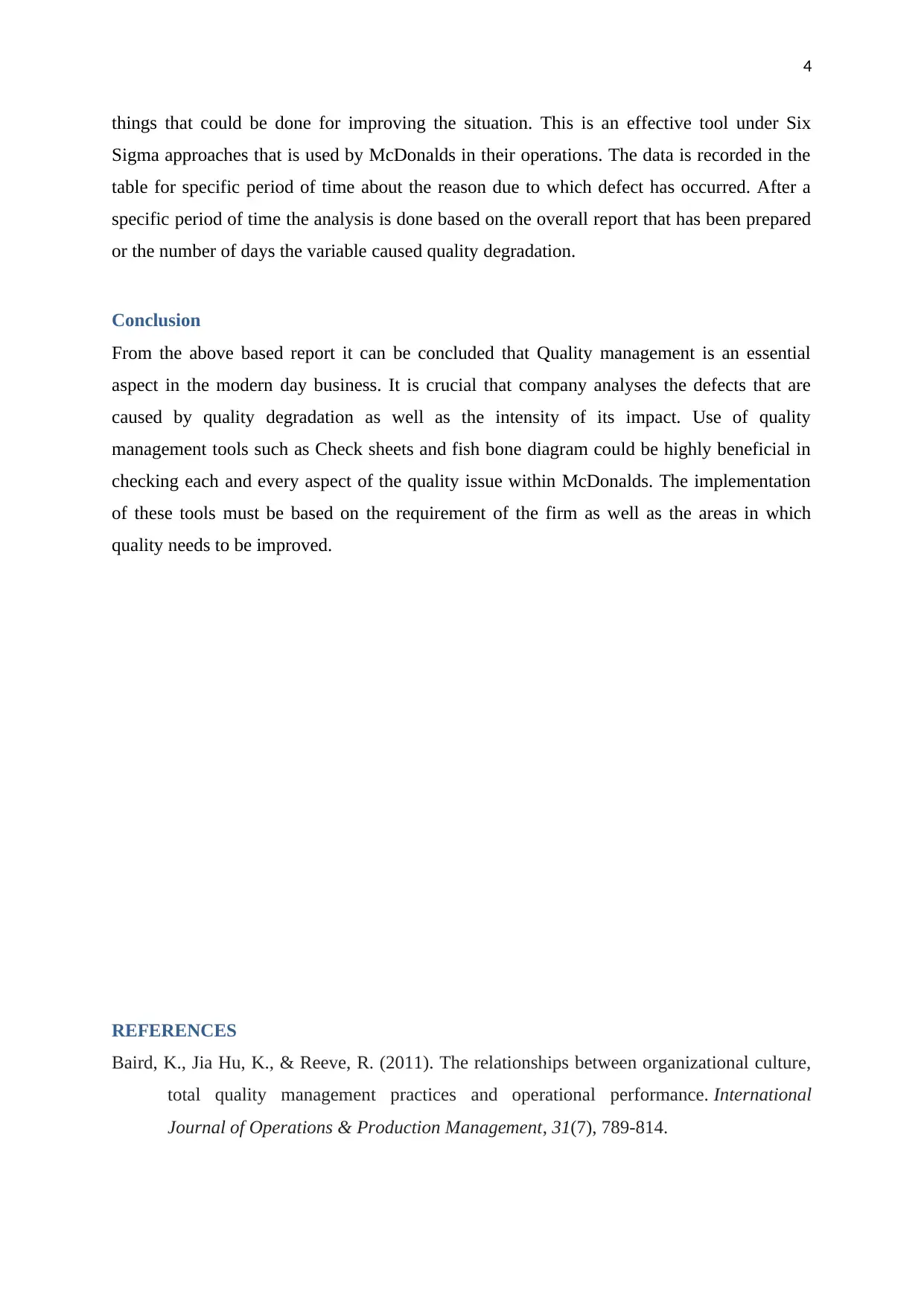
4
things that could be done for improving the situation. This is an effective tool under Six
Sigma approaches that is used by McDonalds in their operations. The data is recorded in the
table for specific period of time about the reason due to which defect has occurred. After a
specific period of time the analysis is done based on the overall report that has been prepared
or the number of days the variable caused quality degradation.
Conclusion
From the above based report it can be concluded that Quality management is an essential
aspect in the modern day business. It is crucial that company analyses the defects that are
caused by quality degradation as well as the intensity of its impact. Use of quality
management tools such as Check sheets and fish bone diagram could be highly beneficial in
checking each and every aspect of the quality issue within McDonalds. The implementation
of these tools must be based on the requirement of the firm as well as the areas in which
quality needs to be improved.
REFERENCES
Baird, K., Jia Hu, K., & Reeve, R. (2011). The relationships between organizational culture,
total quality management practices and operational performance. International
Journal of Operations & Production Management, 31(7), 789-814.
things that could be done for improving the situation. This is an effective tool under Six
Sigma approaches that is used by McDonalds in their operations. The data is recorded in the
table for specific period of time about the reason due to which defect has occurred. After a
specific period of time the analysis is done based on the overall report that has been prepared
or the number of days the variable caused quality degradation.
Conclusion
From the above based report it can be concluded that Quality management is an essential
aspect in the modern day business. It is crucial that company analyses the defects that are
caused by quality degradation as well as the intensity of its impact. Use of quality
management tools such as Check sheets and fish bone diagram could be highly beneficial in
checking each and every aspect of the quality issue within McDonalds. The implementation
of these tools must be based on the requirement of the firm as well as the areas in which
quality needs to be improved.
REFERENCES
Baird, K., Jia Hu, K., & Reeve, R. (2011). The relationships between organizational culture,
total quality management practices and operational performance. International
Journal of Operations & Production Management, 31(7), 789-814.
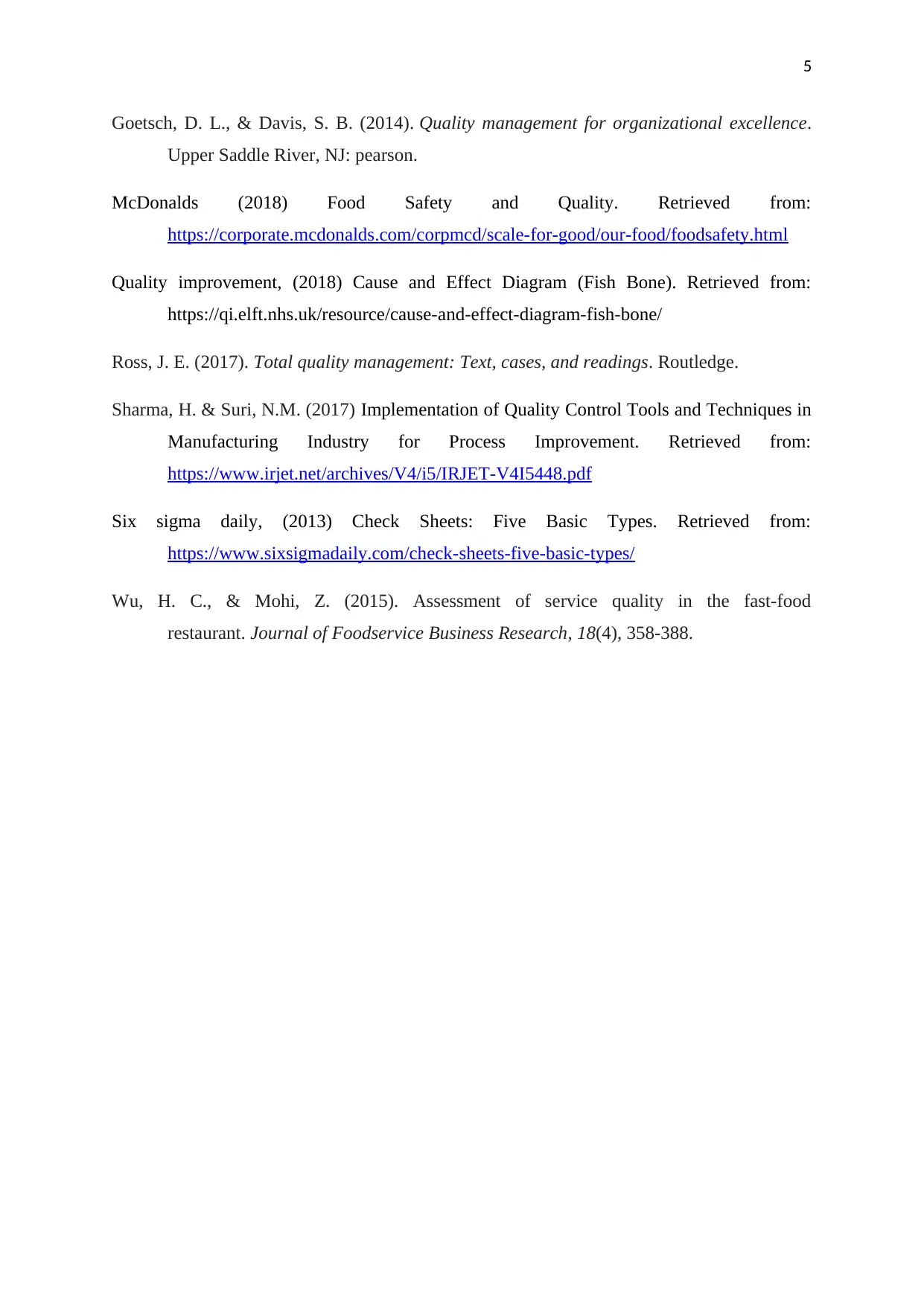
5
Goetsch, D. L., & Davis, S. B. (2014). Quality management for organizational excellence.
Upper Saddle River, NJ: pearson.
McDonalds (2018) Food Safety and Quality. Retrieved from:
https://corporate.mcdonalds.com/corpmcd/scale-for-good/our-food/foodsafety.html
Quality improvement, (2018) Cause and Effect Diagram (Fish Bone). Retrieved from:
https://qi.elft.nhs.uk/resource/cause-and-effect-diagram-fish-bone/
Ross, J. E. (2017). Total quality management: Text, cases, and readings. Routledge.
Sharma, H. & Suri, N.M. (2017) Implementation of Quality Control Tools and Techniques in
Manufacturing Industry for Process Improvement. Retrieved from:
https://www.irjet.net/archives/V4/i5/IRJET-V4I5448.pdf
Six sigma daily, (2013) Check Sheets: Five Basic Types. Retrieved from:
https://www.sixsigmadaily.com/check-sheets-five-basic-types/
Wu, H. C., & Mohi, Z. (2015). Assessment of service quality in the fast-food
restaurant. Journal of Foodservice Business Research, 18(4), 358-388.
Goetsch, D. L., & Davis, S. B. (2014). Quality management for organizational excellence.
Upper Saddle River, NJ: pearson.
McDonalds (2018) Food Safety and Quality. Retrieved from:
https://corporate.mcdonalds.com/corpmcd/scale-for-good/our-food/foodsafety.html
Quality improvement, (2018) Cause and Effect Diagram (Fish Bone). Retrieved from:
https://qi.elft.nhs.uk/resource/cause-and-effect-diagram-fish-bone/
Ross, J. E. (2017). Total quality management: Text, cases, and readings. Routledge.
Sharma, H. & Suri, N.M. (2017) Implementation of Quality Control Tools and Techniques in
Manufacturing Industry for Process Improvement. Retrieved from:
https://www.irjet.net/archives/V4/i5/IRJET-V4I5448.pdf
Six sigma daily, (2013) Check Sheets: Five Basic Types. Retrieved from:
https://www.sixsigmadaily.com/check-sheets-five-basic-types/
Wu, H. C., & Mohi, Z. (2015). Assessment of service quality in the fast-food
restaurant. Journal of Foodservice Business Research, 18(4), 358-388.
⊘ This is a preview!⊘
Do you want full access?
Subscribe today to unlock all pages.

Trusted by 1+ million students worldwide
1 out of 6
Related Documents
Your All-in-One AI-Powered Toolkit for Academic Success.
+13062052269
info@desklib.com
Available 24*7 on WhatsApp / Email
![[object Object]](/_next/static/media/star-bottom.7253800d.svg)
Unlock your academic potential
Copyright © 2020–2025 A2Z Services. All Rights Reserved. Developed and managed by ZUCOL.





